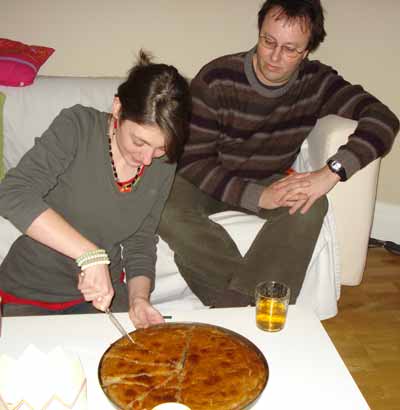
Galette
des Rois is a flat, round cake consisting of flaky puff pastry layers
with a dense filling of frangipane. The cake celebrates the Epiphany
or Fete de Rois (Three Kings Day) and is sold and consumed days
before and after this day. A figurine or trinket “la feve”,
originally a bean, is hidden in the wafer.
It is a type of King Cake.
La Fête Des Rois is the French name for the Christian holiday of Epiphany, celebrated on January 6th, which is 12 days after Christmas. The day is a celebration of when the Three Kings or "wise men" found their way to see the infant Jesus and recognized him as the son of God. King Cake, or galette des rois is traditionally eaten on Epiphany in France as well as in New Orleans. La Fête Des Rois can also refer to a party that is thrown to eat King Cake.
A feast celebrated around the slaughter of a pig when all the edible parts are made ready for use. In France this means pretty much the entire beast. Sausages and black pudding (US: blood sausage).s are prepared, joints and hams are dealt with and the offal (US: organ meat) is assembled. Parts which will not store are eaten as part of the festival.

A galette made with puff pastry with a filling of rich almond paste. A favour, usually a bean, is hidden in the pie and whoever chances upon it as they eat their portion elects the king for the day. This galette is named for the Three Kings, the Magi, and is served on Epiphany. Hence it is a type of king cake.
La fève literally means “broad bean” and currently references the small trinkets or figurines traditionally found in king cakes. In the European tradition, the trinket was an actual bean in which the finding of the bean proclaimed that person the “king of the feast.” These trinkets can take the shape of miscellaneous figurines or crowns. However, tiny figurines that were made in porcelain, and now plastic, have replaced the bean. Tradition also holds that whosoever finds the trinket is proclaimed king for the day and offers the next cake.
The vendange or grape harvest is rounded off by the fête de vendange. It usually involves a vast feast of food and wine and party pieces being performed by one and all. I attended one having picked grapes for the harvest at La Conseillante in St Emilion in 1973. It took me several weeks to recover from this remarkable event. My first marriage had failed and I went to Bordeaux to seek work and was sent out to La Conseillante. I arrived on a chilly afternoon to find two wild girl children running barefoot around the house. After a short while a wonderfully elegant woman arrived to find me sitting on the doorstep looking dejected clutching my rucksack. Amazingly, this chic lady welcomed me into her house, found me an extravagantly beautiful dress and took me to a reception at the house of the Mayor of Libourne. I slept in the upper floor of the chaotic house for a few days until the vendangeurs arrived, gypsies, local workers, Hans from Copenhagen, an unhappy public school boy from England and a few lads from Paris. Over the coming days we worked - boy how we worked - knees cracking as we bent to the vines, we worked our way up and down the lines, with runners taking the full baskets and replacing them with empty ones so that we could never cease the labour. But we sang as we worked and, as the only girl, I was twirled around by various of my workmates when the opportunity arose, and a young gypsy called Philippe courteously carried my basket for me when it become too heavily laden and called the runner for me. At the end of each day we would retire to the monastic dining room, a great barn of a room with wooden beams and long, well worn tables. The food was fabulous - or we were very hungry - and the heavenly wine flowed generously. And then we would stagger to the dormitory which we all shared and Mignon, the farm manager, would heat a vat of wine and spices over a stove in the centre of the room and bring a dip-cup of the mixture to each of us in bed. We slept then. And breakfast each day was a great bowl of coffee, swilled out with wine to get us started! At the end the local workers were called in to be paid, and then the gypsies, ready to move north to the next vendange, and then the foreign workers, all male except me. When I was called, last and alone, Monsieur Bernard said "This was hard work for everyone. But for you it was harder because you are a woman. And so I pay you more." Not bad, eh? I have never really been able to thank that remarkable family for rescuing me at a very sad time in my life.
"King of quails." Corncrake. It is similar to a quail.
Beefsteak mushroom. It may be sliced and fried like liver, or eaten raw with a salad, when it should be cut into thin strips, soaked in salted water, drained and then dressed with a vinaigrette.